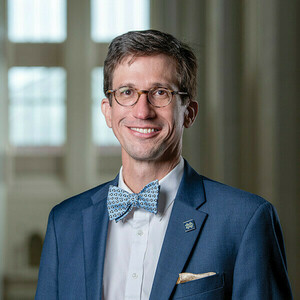Collaboration leads to discovery of how ovarian egg cells may develop
When Lei Lei was an assistant professor at the University of Michigan studying the way germ cells—the precursors to human reproductive cells—form physical “bridges” that help determine their fate, she realized there were no wet-lab experiments that could yield convincing results.

So she turned to a senior member of the faculty, Santiago Schnell. Schnell, who is now William K. Warren Foundation Dean of the College of Science at the University of Notre Dame, is a computational biologist who at that time chaired the Department of Molecular & Integrative Physiology at the University of Michigan Medical School. Together, the research teams discovered a new molecular mechanism for how cells in ovaries, called oocytes, are made available for sustaining ovarian function during the development of fetal ovaries.
Their paper was published recently in Proceedings of the National Academy of Sciences.
“We wanted to see if the outcome on a larger scale matched the snapshot we saw in the lab,” said Lei, now an associate professor of obstetrics and gynecology at the University of Missouri School of Medicine, describing how the mathematical-based computer code contributed to the research: Schnell used his computational skills to help her determine that cell death inside fetal ovaries does not take place randomly.
“This is something we couldn’t do just by doing experiments,” Lei said.
In mammals, there is a large-scale “death” of germ cells in the ovaries of fetuses. This results in only a small proportion of those cells becoming oocytes. Lei’s lab discovered that the germ cells form branched cyst structures, where about 20 percent of the germ cells are connected by three or four physical bridges. In female cysts, the individual germ cells share cellular materials from their sister germ cells. The more connections they make, the better their chance of becoming an oocyte.
“Female cells are all about ‘nursing’ to make a few good oocytes,” Lei said, adding that with male cells, “if one saw something was wrong, the whole cyst structure would collapse.”
Schnell’s model was key to cementing the results Lei had seen. “His lab laid out a really nice computer program, and as we worked on this we found this is a beautiful, and not random process, with how cells decide their fate,” she said.
Other collaborators include first author Kanako Ikami, who was Lei’s postdoctoral researcher and is now at the University of California, Davis; Suzanne Shoffner-Beck, at University of Michigan; Malgorzata Tyczynska Weh, now at the University of South Florida; Shoshei Yoshida, of the School of Life Science in Kanagawa, Japan; and Edgar Andres Diaz Miranda and Sooah Ko, both of the University of Missouri School of Medicine.
Lei appreciates working collaboratively and noted that all areas of the research for this paper took different skill sets, but in working together they can achieve a broader goal.
“Today, science addresses incredibly complex questions conducting research collaboratively,” Schnell said. “Team science is leading to scientific discoveries that wouldn’t have been possible otherwise, resulting in greater scientific impact, innovation and productivity than the single investigator approaches.”
Originally published by at science.nd.edu on June 05, 2023.
Latest Research
- Component of keto diet plus immunotherapy may reduce prostate cancerAdding a pre-ketone supplement — a component of a high-fat, low-carb ketogenic diet — to a type of cancer therapy in a laboratory setting was highly effective for treating prostate cancer, researchers from the University of Notre Dame found.
- Senator Todd Young and NSF Director Sethuraman Panchanathan visit Notre Dame to discuss critical investments in science and technologyOn Thursday, April 25, Sethuraman Panchanathan, director of U.S. National Science Foundation (NSF), joined U.S. Senator Todd Young in a visit to the campus of the University of Notre Dame. The pair met with faculty, students, and University leaders and discussed how research and innovation can drive…
- White House’s Jake Braun addresses statewide cybersecurity summit at Notre DameOn April 18, 2024, leaders in cybersecurity from government, industry, and academia gathered for the 2024 Indiana Statewide Cybersecurity Summit hosted by the University of Notre Dame in collaboration with co-sponsors Indiana University, Purdue University,…
- Hauenstein, Putman named as Simons FellowsTwo University of Notre Dame professors were named fellows of the Simons Foundation for 2024, which will allow them the opportunity to intensely focus on their research for up to a year. Jonathan…
- Literacy scholar Ernest Morrell elected to American Academy of Arts & SciencesErnest Morrell, the Coyle Professor of Literacy Education at the University of Notre Dame, has been elected to the American Academy of Arts and Sciences, one of the nation’s oldest learned societies and independent policy research centers. Morrell was one of the 250 members of the newest AAAS class announced today. Other notable names among the group include filmmaker George Clooney, Apple CEO Tim Cook, novelist Jhumpa Lahiri, and Pulitzer Prize-winning New York Times columnist and 1993 Notre Dame alumnus Carlos Lozada.
- Notre Dame faculty fight malaria resurgence in BangladeshBetween 2008 and 2020, districts across the country of Bangladesh saw a 93% reduction in malaria cases. Today, as the world reflects on the World…













